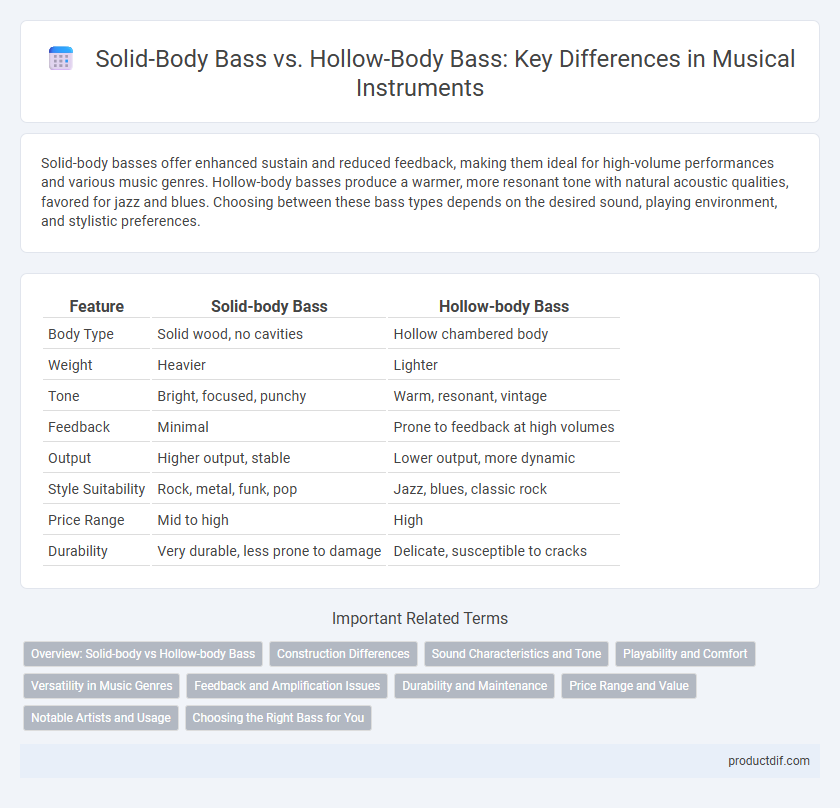Solid-body basses offer enhanced sustain and reduced feedback, making them ideal for high-volume performances and various music genres. Hollow-body basses produce a warmer, more resonant tone with natural acoustic qualities, favored for jazz and blues. Choosing between these bass types depends on the desired sound, playing environment, and stylistic preferences.
Table of Comparison
| Feature | Solid-body Bass | Hollow-body Bass |
|---|---|---|
| Body Type | Solid wood, no cavities | Hollow chambered body |
| Weight | Heavier | Lighter |
| Tone | Bright, focused, punchy | Warm, resonant, vintage |
| Feedback | Minimal | Prone to feedback at high volumes |
| Output | Higher output, stable | Lower output, more dynamic |
| Style Suitability | Rock, metal, funk, pop | Jazz, blues, classic rock |
| Price Range | Mid to high | High |
| Durability | Very durable, less prone to damage | Delicate, susceptible to cracks |
Overview: Solid-body vs Hollow-body Bass
Solid-body basses feature a solid wooden body that enhances sustain and reduces feedback, making them ideal for various music genres and high-volume performances. Hollow-body basses have a resonant, chambered design that produces a warm, acoustic tone with natural resonance but are more prone to feedback at high volumes. The choice between solid-body and hollow-body basses depends on tonal preference, playing style, and setting, with solid-body offering durability and clarity, while hollow-body provides a vintage, mellow sound.
Construction Differences
Solid-body bass guitars feature a solid wood core, typically made from materials like alder, ash, or mahogany, which enhances sustain and reduces feedback during high-volume play. Hollow-body basses incorporate a resonant chamber within their wooden frame, often constructed from maple or spruce, producing a warmer, more acoustic-like tone but increasing susceptibility to feedback. Construction differences directly affect the instrument's weight, tone characteristics, and suitability for various music genres.
Sound Characteristics and Tone
Solid-body basses produce a tight, focused sound with pronounced sustain and reduced feedback, making them ideal for genres requiring clarity and punch such as rock and funk. Hollow-body basses offer a warmer, resonance-rich tone with enhanced acoustic qualities and natural overtones, favored in jazz and blues for their woody, mellow sound. The choice between solid-body and hollow-body influences tonal brightness, attack, and resonance, directly affecting the instrument's suitability for different musical styles.
Playability and Comfort
Solid-body bass guitars typically offer greater playability and comfort due to their lighter weight and reduced feedback, making them ideal for extended performances and various playing styles. Hollow-body basses, while providing a warmer, more resonant tone, tend to be heavier and can cause more feedback at high volumes, which may affect comfort and ease of play. Players valuing ergonomic design and versatile sound often prefer solid-body basses for a more consistent and comfortable playing experience.
Versatility in Music Genres
Solid-body bass guitars excel in rock, metal, and funk due to their resistance to feedback and strong, punchy tone, making them highly versatile across high-energy genres. Hollow-body basses offer warm, resonant sound suited for jazz, blues, and indie music, delivering rich harmonic overtones preferred in more mellow or acoustic settings. Musicians choose solid-body basses for amplified performances and hollow-body basses when seeking natural, woody tones with moderate volume and enhanced expression.
Feedback and Amplification Issues
Solid-body bass guitars exhibit superior resistance to feedback due to their dense construction, making them ideal for high-volume amplification in live performances. Hollow-body basses, featuring resonant chambers, are more prone to unwanted feedback, especially at higher gain settings or with aggressive playing styles. Amplification setups for hollow-body basses often require careful EQ adjustments and feedback suppression techniques to maintain clarity and prevent distortion.
Durability and Maintenance
Solid-body bass guitars offer superior durability due to their dense, solid wood construction which resists damage from impacts and humidity fluctuations, making them ideal for touring musicians. Hollow-body basses require more delicate maintenance as their thin, resonant wood shells are susceptible to cracks, warping, and feedback issues, necessitating careful handling and controlled environmental conditions. Choosing a solid-body bass reduces the need for frequent repairs and maintenance, ensuring long-lasting playability and reliability in diverse settings.
Price Range and Value
Solid-body bass guitars typically range between $300 and $1,500, offering durability and consistent sound ideal for various music styles, providing excellent value for beginners and gigging musicians. Hollow-body basses usually cost from $800 to over $3,000, delivering rich, resonant tones suited for jazz and blues but requiring more maintenance, reflecting their premium value for tone quality. Choosing between solid-body and hollow-body basses depends on balancing budget constraints with desired sound characteristics and performance needs.
Notable Artists and Usage
Solid-body basses, favored by artists like Flea of the Red Hot Chili Peppers and Geddy Lee of Rush, are prevalent in genres requiring punchy, sustained tones such as rock, funk, and metal. Hollow-body basses, used by musicians like Les Claypool and Charlie Haden, excel in jazz, blues, and vintage rock due to their warm, resonant sound and feedback sensitivity. The choice between solid-body and hollow-body basses significantly influences the tonal character and playing style tailored to specific musical contexts.
Choosing the Right Bass for You
Solid-body bass guitars deliver powerful sustain and feedback resistance, ideal for rock and metal genres, while hollow-body basses produce warm, resonant tones suited for jazz and blues. Consider your playing style and preferred sound to select the right bass; solid-body models like the Fender Precision offer punchy articulation, whereas hollow-body basses such as the Gibson EB-2 provide rich, vintage warmth. Weight and feedback sensitivity are key factors--solid-body basses tend to be heavier but more stable on stage, while hollow-body basses require careful amplification to avoid unwanted feedback in live settings.
Solid-body Bass vs Hollow-body Bass Infographic

 productdif.com
productdif.com